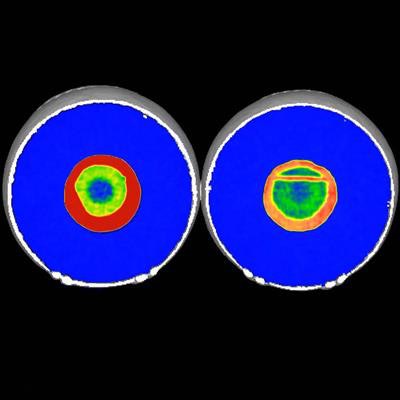
CT may have helped researchers uncover why there's been an explosion of home runs in Major League Baseball (MLB). A group from California and Ohio scanned baseballs and found that their density has dipped in recent years -- supporting suspicions that "juiced balls" are behind the power surge.
The investigators examined the makeup of MLB baseballs before and after the 2015 All-Star Game using CT and various laboratory techniques. They discovered that there were statistically significant differences in the density and chemical composition of the baseballs: The cores of baseballs used after the All-Star Game were more porous and less dense than those of baseballs used prior to the midsummer classic.
"One can hypothesize that if there is a change in the composition of the balls, it may result in the balls flying further or having a different trajectory," Dr. Meng Law, director of neuroradiology at the University of Southern California (USC), told AuntMinnie.com. "Again, hypothetically, if this impacts the numbers of home runs hit in a season, it also potentially impacts MLB statistics and player contracts."
Juiced ball theory
 Dr. Meng Law from USC.
Dr. Meng Law from USC.
What was the cause of this sudden upward swing in home run totals?
One possible explanation is that MLB baseballs now have a higher coefficient of restitution, or bounciness, than before, according to a report by FiveThirtyEight. This juiced ball theory posits that manufacturers may have increased the distance and speed at which a baseball will travel after a hit by decreasing ball size, altering ball seams, or changing the constitution of its core, which is made up of a cork center surrounded by a middle layer of black rubber and an outer layer of pink rubber.
To test this supposition, a team that include Meng as well as Dr. Jay Acharya and Dr. Darryl Hwang of USC acquired CT scans of eight baseballs manufactured by MLB baseball provider Rawlings and evaluated their density based on the scans. Four of the baseballs were MLB game balls used between August 2014 and May 2015, three were game balls used between August 2016 and July 2017, and one was a brand-new ball. They used MLB's authenticator program to confirm that the seven game balls came from an actual game.
After scanning the baseballs with CT, Law and colleagues found statistically significant differences between the densities in Hounsfield units of the baseball cores used before and after the 2015 MLB All-Star Game in July. There was no noteworthy variation in density among balls from same period.
Lower core density
On the whole, the cores of baseballs used after the 2015 All-Star Game were less dense than the cores of baseballs used beforehand. Of note, the pink rubber layer of the newer balls was approximately 40% less dense than the same layer in the older balls.
| Density of MLB baseball cores on CT, before and after July 2015 | ||||||
| Before the 2015 MLB All-Star Game | After the 2015 MLB All-Star Game | |||||
| Inner cork | Black rubber | Pink rubber | Inner cork | Black rubber | Pink rubber | |
| Mean ball density in Hounsfield units | 181.6 | 222.75 | 551.05 | 191.25 | 230.55 | 312.7 |
Not only was the overall density of the cores of newer baseballs lower by a statistically significant degree (p < 0.05), but their chemical composition was also considerably different from that of the old balls.
By cutting open the eight baseballs, Soumitra Basu, PhD, and colleagues at Kent State University were able to use thermogravimetric analysis and a scanning electron microscope to study the chemical makeup of the balls. The examination revealed that the pink layer of the cores of the newer baseballs contained 7% more polymer and 10% less silicone, on average, than the same layer in the older balls.
Collectively, these changes resulted in a more porous, less dense layer of rubber, which led to an average drop of 0.5 g from the core of the newer baseballs, according to Basu.
CT scans of baseballs from the 2014 MLB season (left) and the 2017 MLB season (right). Video courtesy of Dr. Meng Law.
"These slight changes in the chemical composition of the core could have an impact on how the balls played," wrote FiveThirtyEight baseball columnist Rob Arthur and writer Tim Dix, commenting on the results. "When combined with previous research finding that baseballs began to change in other small ways starting around the same time, it suggests that a number of minor differences may have combined to contribute to the remarkable upswing in home run power we've witnessed since 2015."
Imaging in sports
In light of these and related findings, MLB Commissioner Rob Manfred requested that all teams begin storing baseballs in a climate-controlled room, and he approved an investigation by scientists and statisticians on ball juicing in 2017.
With the inquiry afoot, Law and colleagues have expanded the scope of their research and are now exploring the role of imaging in other sports. The group presented research at the 2017 American Society of Neuroradiology (ASNR) meeting in Long Beach, CA, concerning changes to athletes' brains evident on MRI after they meditate.
"We have also presented work on the effects of mindfulness and meditation on golf performance and MRI changes in the brain," Law said. "We have found that mindfulness can increase some gray-matter areas in the brain."




















